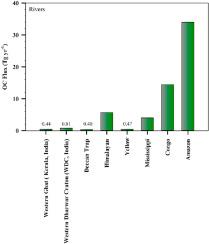Importance of small, Western Ghats-originated Indian rivers in the regional carbon cycle: A focus on sediment organic carbon dynamics
IF 2.6
3区 地球科学
Q1 MARINE & FRESHWATER BIOLOGY
引用次数: 0
Abstract
Rivers play an important role as primary conduits in the global biogeochemical cycles of major nutrients and minor elements. Despite their significance, the geographical distribution of elemental loads in rivers has not received an extensive research attention. The complex biogeochemical processes governing elemental cycling in rivers, estuaries, and oceans are linked to the presence of organic matter. Here we determined the contents of sand, fine sediment fraction (<75 μm), organic carbon (OC), biogenic silica (BSi) and reactive iron (FeR) in surface sediments of seven, Western Ghats-originated small rivers of Kerala, South India to understand the factors controlling accumulation and preservation of OC. Results indicated that the binding mechanisms of OC in sediments among the studied rivers are dissimilar, as they vary according to the specific environmental conditions of the depositional site. We found that approximately 50 % of OC was associated with fine sediment fraction in these rivers, indicating the source of OC exerts a strong control of OC accumulation in sediments. The interlaced relationships among OC, BSi, and FeR observed in riverine and estuarine sediments reveal the complexity of environmental factors that contributes to the varied correlation on the preservation of OC across the studied rivers. Additionally, we quantified the flux and stock of OC, BSi and FeR in these minor rivers and compared them to other rivers in India and world to highlight their global significance in biogeochemical cycles. Our estimates revealed that these mountainous rivers transport a range of 0.17–1.26 Tg C yr−1 in the form of organic carbon with a mean OC flux of 0.44 Tg C yr−1 which is approximately 0.09 % of the global riverine organic flux (480 Tg C yr−1). Likewise, these rivers contain OC stocks ranging from 52.4 to 110.5 t ha−1 with a mean OC stock of 82.8 t ha−1. The Periyar River stands out with the highest OC flux (1.26 ± 0.32 Tg C yr−1) and stock (110.5 t ha−1) among the studied rivers.

源自西高止山脉的印度河流在区域碳循环中的重要性:沉积物有机碳动态的焦点
河流在全球主要营养元素和次要元素的生物地球化学循环中起着主要的管道作用。尽管具有重要意义,但河流中元素负荷的地理分布尚未得到广泛的研究关注。控制河流、河口和海洋元素循环的复杂生物地球化学过程与有机物的存在有关。本文测定了印度南部喀拉拉邦7条西高止山脉小河流表层沉积物中砂、细沉积物组分(<75 μm)、有机碳(OC)、生物源二氧化硅(BSi)和活性铁(FeR)的含量,以了解控制OC积累和保存的因素。结果表明,各研究河流沉积物中有机碳的结合机制存在差异,因沉积地点的特定环境条件而异。研究发现,这些河流中约50%的OC与细沙组分有关,表明OC的来源对沉积物中OC的积累有很强的控制作用。河流和河口沉积物中OC、BSi和FeR之间的交错关系揭示了环境因素的复杂性,这些因素导致了所研究河流中OC保存的不同相关性。此外,我们量化了这些小河流的OC、BSi和FeR的通量和储量,并将其与印度和世界其他河流进行了比较,以突出它们在生物地球化学循环中的全球意义。我们的估计表明,这些山地河流以有机碳的形式输送了0.17-1.26 Tg C yr - 1,平均碳通量为0.44 Tg C yr - 1,约占全球河流有机通量(480 Tg C yr - 1)的0.09%。同样,这些河流的OC储量在52.4 ~ 110.5 t ha - 1之间,平均OC储量为82.8 t ha - 1。其中,Periyar河的OC通量(1.26±0.32 Tg C yr - 1)和储量(110.5 t ha - 1)最高。
本文章由计算机程序翻译,如有差异,请以英文原文为准。
求助全文
约1分钟内获得全文
求助全文
来源期刊
CiteScore
5.60
自引率
7.10%
发文量
374
审稿时长
9 months
期刊介绍:
Estuarine, Coastal and Shelf Science is an international multidisciplinary journal devoted to the analysis of saline water phenomena ranging from the outer edge of the continental shelf to the upper limits of the tidal zone. The journal provides a unique forum, unifying the multidisciplinary approaches to the study of the oceanography of estuaries, coastal zones, and continental shelf seas. It features original research papers, review papers and short communications treating such disciplines as zoology, botany, geology, sedimentology, physical oceanography.

 求助内容:
求助内容: 应助结果提醒方式:
应助结果提醒方式:


